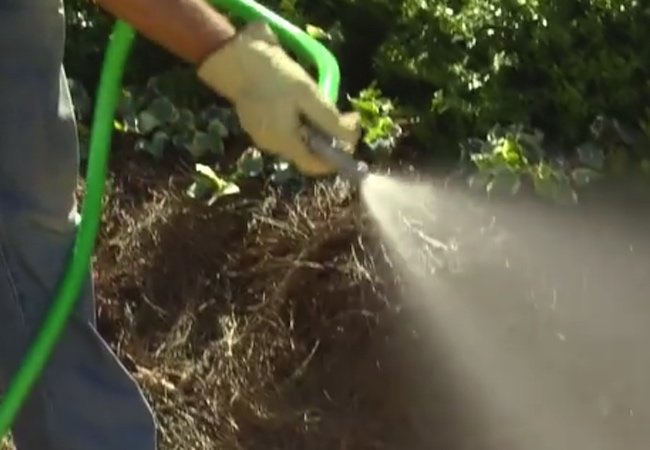We may earn revenue from the products available on this page and participate in affiliate programs. Learn More ›
Durability ranks high among the many reasons to choose concrete as a driveway surfacing material. After years of exposure to the elements, however, as well as to foot and vehicle traffic, your concrete driveway may begin to look worse for all that wear. Rather than rip it all out and start from scratch, it’s far easier and much cheaper to renew the existing installation.QUIKRETE® Concrete Resurfacer will protect against future damage and discoloration while making your old driveway look new again. If you think your concrete driveway has reached the end of the road, read on and learn how easy it can be to give it a second life.

Tools & Materials
Bobvila.com may earn a commission from purchases made through these links.

STEP 1: Clean your concrete driveway and patch as needed.
Before applying QUIKRETE® Concrete Resurfacer, prepare the old concrete surface so that the renewing layer can properly adhere to it. Start by eliminating dirt, oil, and flaking concrete with a 3,500-psi pressure washer. (Note that if you don’t happen to own a pressure washer, you can always rent one at your local home center.)
Once you have cleaned the driveway, inspect it for large cracks or deeply spalled areas, being sure to repair any with patching compound. Finally, hose down the driveway to the point of saturation, then use a broom to remove standing water. Doing so cools down the slab and prevents the mixing water from being drawn out of the wet concrete resurfacer you’re going to lay down. Now, pause to consider the weather: For the resurfacer to cure, temperatures must remain above 50 degrees Fahrenheit for eight hours, and above freezing for 24 hours. So long as you expect those conditions, it’s safe to proceed to the next step.

STEP 2: Mix your concrete resurfacer to a syrup consistency.
QUIKRETE® Concrete Resurfacer isn’t your typical concrete product; as a result, your typical mixing method may not be appropriate here. Being that hand-mixing so often leaves lumps, it’s recommended that you use a power drill that’s outfitted not with a barrel-type attachment, but with a paddle mixer.
Now, with your equipment ready, go ahead and recruit a helper—you’re going to need an extra pair of hands. First, add three and a half quarts of water to a five-gallon bucket. Next, while you operate the mixing paddle within the bucket, ask your helper to slowly pour in the resurfacer. After it’s all been added, continue mixing for at least five minutes. Stop only once the mix has reached a lump-free, syrup-like consistency. If the mix seems too thick, add a bit more water; if too thin, add a bit more resurfacer. As you’re mixing, your helper can fit weatherstripping into the expansion joints of the driveway to prevent the resurfacer from filling them.

STEP 3: Spread the concrete resurfacer over small sections of the driveway, and work quickly.
In 73-degree weather, QUIKRETE® Concrete Resurfacer remains workable for 30 minutes. In hotter weather, it hardens more quickly, but by keeping the bag in the shade and using cold mixing water, you can widen the window of workability. Resurfacing a large driveway? It may be wise to work in sections, mixing and applying resurfacer on one modestly sized area (no larger than 144 square feet) at a time.
Once it’s ready, pour the resurfacer from the mixing bucket onto the driveway in strips about a foot wide. Then, with a long-handled squeegee, spread the material back and forth across the driveway, effectively scrubbing the resurfacer into the concrete. After allowing the smooth new surface to set for five minutes, you can give it a nonslip finish, if you choose, with a wide-head concrete broom. For a uniform appearance, run the broom, without stopping, across the work area, and be sure to make each broom stroke in the same direction.

STEP 4: Wait six hours after you’ve resurfaced a concrete driveway before walking on it and 24 hours before driving over it.
Believe it or not, that’s all it takes to renew the look of your driveway for the life of the concrete slab. In mild weather, the resurfacer cures on its own, requiring no extra steps. If it’s very hot—above 90 degrees—QUIKRETE® recommends misting the driveway intermittently for up to 48 hours after application.
Most of the time, however, you can expect the new surface to be ready for foot traffic in about six hours. And in 24 hours, you can pull your car in and park in the driveway again—that very same driveway that was tired- and worn-looking yesterday but, thanks to QUIKRETE® Concrete Resurfacer, appears brand-new today.
See how to resurface a concrete driveway in a step-by-step video, courtesy of QUIKRETE®!

For more even more details on concrete driveway resurfacing, visit QUIKRETE®.
This post has been brought to you by QUIKRETE®. Its facts and opinions are those of BobVila.com.

